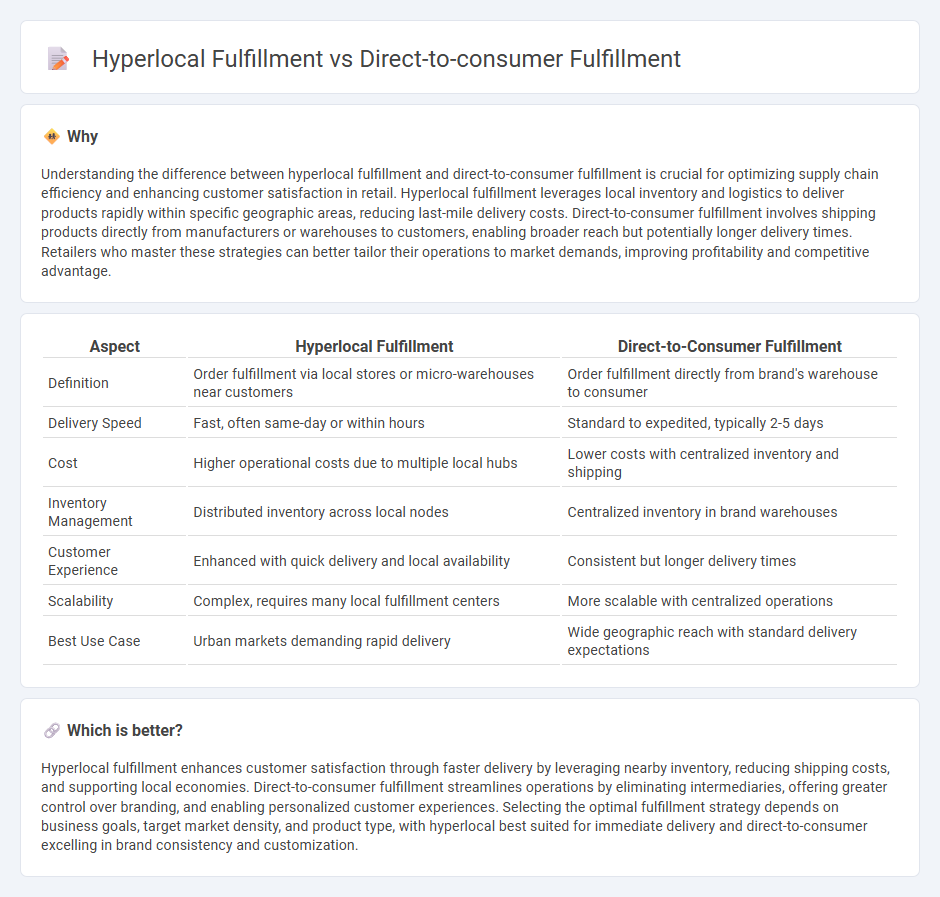
Hyperlocal fulfillment leverages proximity by storing products in local hubs, enabling faster delivery and reduced shipping costs for retailers. Direct-to-consumer fulfillment involves shipping products directly from manufacturer or central warehouses to customers, focusing on broader reach but often longer delivery times. Explore the advantages and challenges of each method to optimize your retail fulfillment strategy.
Why it is important
Understanding the difference between hyperlocal fulfillment and direct-to-consumer fulfillment is crucial for optimizing supply chain efficiency and enhancing customer satisfaction in retail. Hyperlocal fulfillment leverages local inventory and logistics to deliver products rapidly within specific geographic areas, reducing last-mile delivery costs. Direct-to-consumer fulfillment involves shipping products directly from manufacturers or warehouses to customers, enabling broader reach but potentially longer delivery times. Retailers who master these strategies can better tailor their operations to market demands, improving profitability and competitive advantage.
Comparison Table
| Aspect | Hyperlocal Fulfillment | Direct-to-Consumer Fulfillment |
|---|---|---|
| Definition | Order fulfillment via local stores or micro-warehouses near customers | Order fulfillment directly from brand's warehouse to consumer |
| Delivery Speed | Fast, often same-day or within hours | Standard to expedited, typically 2-5 days |
| Cost | Higher operational costs due to multiple local hubs | Lower costs with centralized inventory and shipping |
| Inventory Management | Distributed inventory across local nodes | Centralized inventory in brand warehouses |
| Customer Experience | Enhanced with quick delivery and local availability | Consistent but longer delivery times |
| Scalability | Complex, requires many local fulfillment centers | More scalable with centralized operations |
| Best Use Case | Urban markets demanding rapid delivery | Wide geographic reach with standard delivery expectations |
Which is better?
Hyperlocal fulfillment enhances customer satisfaction through faster delivery by leveraging nearby inventory, reducing shipping costs, and supporting local economies. Direct-to-consumer fulfillment streamlines operations by eliminating intermediaries, offering greater control over branding, and enabling personalized customer experiences. Selecting the optimal fulfillment strategy depends on business goals, target market density, and product type, with hyperlocal best suited for immediate delivery and direct-to-consumer excelling in brand consistency and customization.
Connection
Hyperlocal fulfillment and direct-to-consumer fulfillment are interconnected through their shared focus on reducing delivery times and enhancing customer satisfaction by leveraging localized inventory and customized supply chains. Retailers utilize hyperlocal fulfillment centers strategically placed near end consumers to enable faster, more efficient direct-to-consumer deliveries, minimizing last-mile logistics costs and improving order accuracy. This synergy empowers brands to respond swiftly to consumer demands while optimizing inventory management and reducing overall fulfillment expenses.
Key Terms
Source and External Links
Direct-to-Consumer Fulfillment: How It Works - ShipHero - Direct-to-consumer fulfillment (D2C) is when companies sell products directly to consumers, bypassing retailers, allowing full control over supply chain, improving customer experience, and increasing profit margins by eliminating intermediaries.
Direct-to-Consumer (D2C) Fulfillment Guide: Strategy & Best Practices - D2C fulfillment involves shipping products directly from a brand's warehouse to customers, managing inventory and delivery internally to reduce costs and speed delivery while gaining better customer data and control over branding.
What Is DTC Fulfillment? Benefits, Challenges and Steps - Shopify - DTC fulfillment delivers products directly to customers without retail partners, offering higher control and profit margins but requiring brands to manage inventory, packing, and shipping themselves, with possible help from third-party providers.
 dowidth.com
dowidth.com